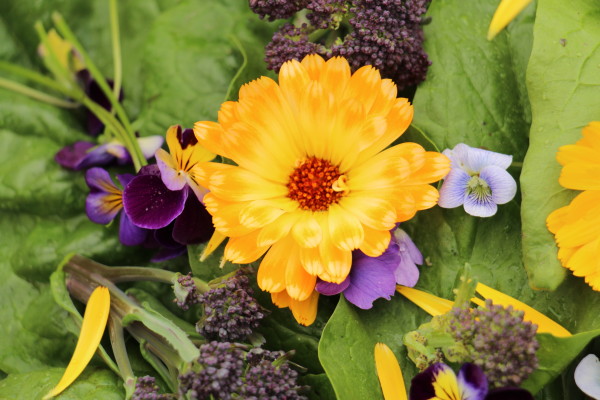 Okay, so the placement of a whole calendula was to get your attention. You wouldn’t eat the entire thing but the flower’s yellow petals, along with the Johnny jump-ups, violets, and Roman (purple) Broccoli would have been beautiful and completely edible additions to salads of the wealthy in colonial Virginia!
Okay, so the placement of a whole calendula was to get your attention. You wouldn’t eat the entire thing but the flower’s yellow petals, along with the Johnny jump-ups, violets, and Roman (purple) Broccoli would have been beautiful and completely edible additions to salads of the wealthy in colonial Virginia!
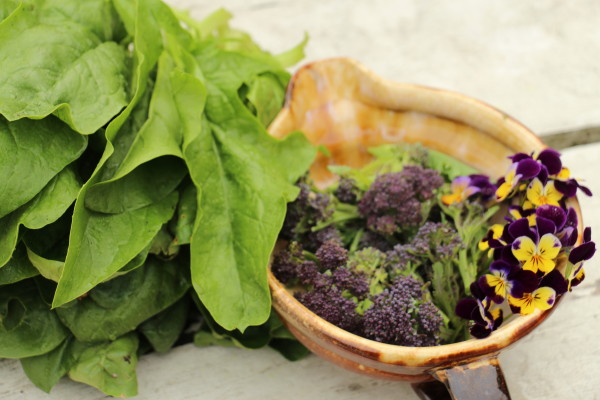 We learned this tasty historical tidbit when we visited our Colonial Garden to meet up with apprentices Jen Mrva and Emily Nelson. We’ll get to the beautiful edible flowers in a minute. First, let’s talk about the main focus of the salad which is our spinach. In the 18th century, you would have seen both the prickly-seeded and broad-leafed spinach in Williamsburg.
We learned this tasty historical tidbit when we visited our Colonial Garden to meet up with apprentices Jen Mrva and Emily Nelson. We’ll get to the beautiful edible flowers in a minute. First, let’s talk about the main focus of the salad which is our spinach. In the 18th century, you would have seen both the prickly-seeded and broad-leafed spinach in Williamsburg.
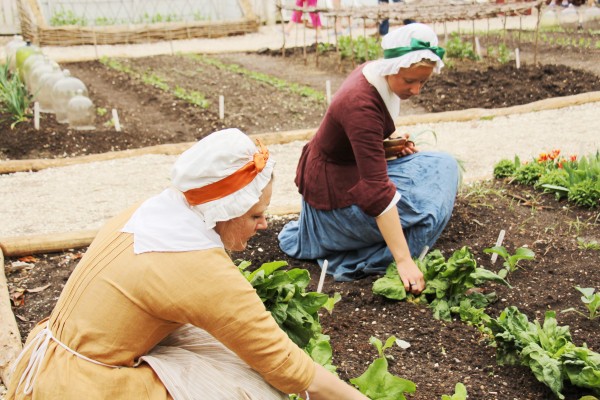 Both varieties have been growing through the winter in our historic garden and the snow actually provided them with a layer of insulation. Amazingly, there was no need to cover or protect the plants. As you can see, they came up just fine and will keep producing until we start to get really hot weather.
Both varieties have been growing through the winter in our historic garden and the snow actually provided them with a layer of insulation. Amazingly, there was no need to cover or protect the plants. As you can see, they came up just fine and will keep producing until we start to get really hot weather.
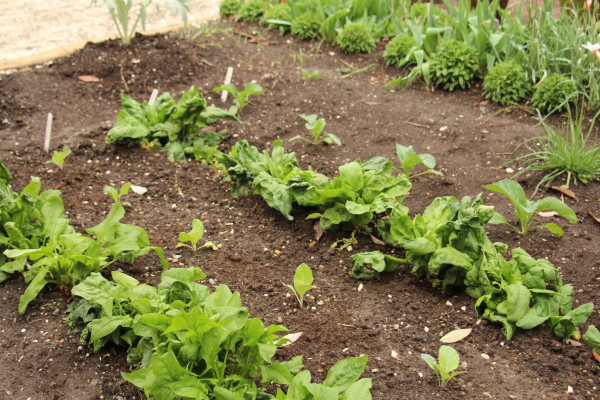 Next up—the beautiful Roman (purple) Broccoli which was the most popular variety in the 18th century. Jen says unlike modern broccoli which you cut once and it’s done—this version can be picked every two or three days. It’s the gift that keeps on giving! The plants originated from tall kale somewhere in the eastern end of the Mediterranean before moving into Italy. By the 1730s, they had arrived in the colonies—about the same time we first started hearing about them in England.
Next up—the beautiful Roman (purple) Broccoli which was the most popular variety in the 18th century. Jen says unlike modern broccoli which you cut once and it’s done—this version can be picked every two or three days. It’s the gift that keeps on giving! The plants originated from tall kale somewhere in the eastern end of the Mediterranean before moving into Italy. By the 1730s, they had arrived in the colonies—about the same time we first started hearing about them in England.
 The florets eventually bloom yellow but you don’t want to eat them in the flower form. Instead, you want to pick them when they’re at this stage. So how do they taste? I couldn’t just take Jen and Emily’s word for it so I tried a piece for myself. It was delicious even in raw form—a little sweeter than the broccoli you would normally find in the grocery store. While there’s no direct evidence that would suggest colonists would have added broccoli to their salads, Jen says it’s a definite possibly so we’re going with it!
The florets eventually bloom yellow but you don’t want to eat them in the flower form. Instead, you want to pick them when they’re at this stage. So how do they taste? I couldn’t just take Jen and Emily’s word for it so I tried a piece for myself. It was delicious even in raw form—a little sweeter than the broccoli you would normally find in the grocery store. While there’s no direct evidence that would suggest colonists would have added broccoli to their salads, Jen says it’s a definite possibly so we’re going with it!
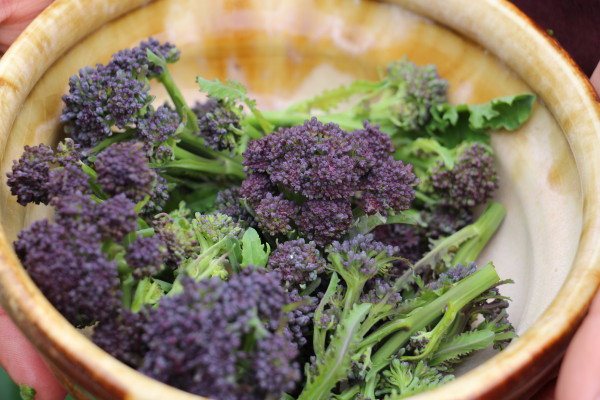 Next, Jen and Emily picked some beautiful Johnny jump-ups. The cooks in our Historic Foodways program often sugar these beautiful flowers to decorate cakes in the Palace kitchen. In the 18th century, they would have also been used in salads and as garnishes for certain dishes. But again, this would have mainly been the case for the more affluent families who could afford the luxury of serving fresh ingredients immediately after picking.
Next, Jen and Emily picked some beautiful Johnny jump-ups. The cooks in our Historic Foodways program often sugar these beautiful flowers to decorate cakes in the Palace kitchen. In the 18th century, they would have also been used in salads and as garnishes for certain dishes. But again, this would have mainly been the case for the more affluent families who could afford the luxury of serving fresh ingredients immediately after picking.
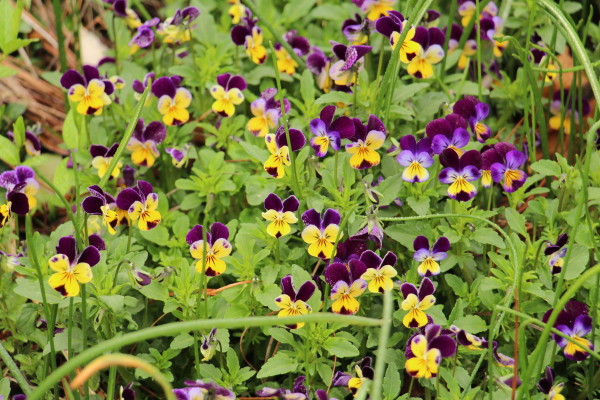 The cooks use an 18th-century cookbook by Hannah Glasse as their reference for these edible flowers. According to their records, some redbud flowers and rose petals were also used. Both pretty and pretty tasty!
The cooks use an 18th-century cookbook by Hannah Glasse as their reference for these edible flowers. According to their records, some redbud flowers and rose petals were also used. Both pretty and pretty tasty!
 Finally, we mixed all our ingredients together in our version of an 18th-century salad that could have very easily been served in the Governor’s Palace on this very day in 1776. As a final touch, we added the petals of a yellow calendula which were also used to color dough and butter. The other pop of purple is thanks to our edible violets.
Finally, we mixed all our ingredients together in our version of an 18th-century salad that could have very easily been served in the Governor’s Palace on this very day in 1776. As a final touch, we added the petals of a yellow calendula which were also used to color dough and butter. The other pop of purple is thanks to our edible violets.
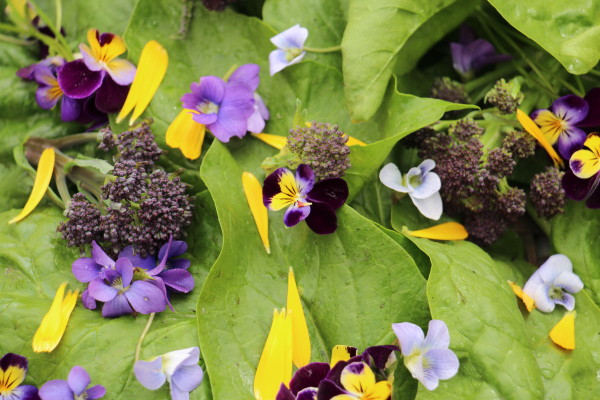
UPDATE: Some of you have commented or emailed asking whether dressing was used for salads in the 18th century. Our “History is Served” blog listed this recipe for a mustard/vinegar version. In the same post, Frank Clark from our Historic Foodways also wrote that salads were served between the main meal and dessert, not as an appetizer. Pretty interesting!
Tell us, would you try our salad, including the flowers?
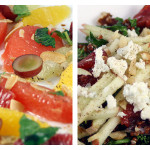
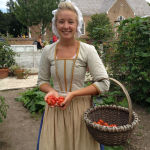

I loved my visit to Willimsnburg a few years ago (see photo). I am from Whitehaven, Lake District Coast, Cumbria - was the 3rd largest port in England from whence quite of the original inhabitants of Williamsburg came with their goods and chattels - even if they lived in other towns such as Kendal or Penrith or Alnwick many would travel from our port. John Paul Jones raided here in 1778. George Washington’s grandmother is buried here. I grow Cardoon in my garden, but don’t eat it (an acquired taste!), though I know ancestors did and Williamsburg gardeners have it as something they ate. Calendula - marigold petals were also used like saffron and are very nice in the dough/batter of cup-cakes/muffins. I have done this for decades and the cakes were from an old recipe - as well as using them in salad. Regards Helen - who lives just up the hill from the quarry where they still obtain the stone for George Washington’s Mount Vernon’s Piazza - like they always have done.
I am not a fan of broccoli, but the purple stuff looks pretty good. I would venture to guess that I would try it. The colors are beautiful. Most of my salads are boring green, upon green upon green. Some bright colors would make it look more appealing. Thank you for sharing these tiny tidbits. It is amazing that we are still able to learn, even after finishing school.
Dora - I’m like you - you don’t know until you try it! If you ever do, you’ll have to let me know what you think. In the summer, I like to add diced red and yellow peppers, carrots, and purple onions to my salad to give it pops of color!
Is there any indication that the 18th century salads were served with a dressing?
That’s a great question, Donn! I will reach out to Frank Clark with our Historic Foodways program and see what I can find out.
Donn, according to our “History is Served” blog - they did indeed use dressing! Here’s a recipe. I’m going to update the blog!
http://recipes.history.org/2013/08/to-dress-salad/